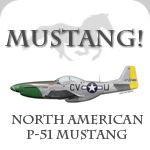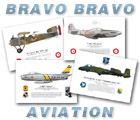German Mustangs
During World War II, belligerents actively searched reliable data concerning their opponent's equipment. This was particularly true of air forces, which could obtain a decisive tactical advantage if given the opportunity to examine enemy aircraft. The most famous example of this was the Japanese A6M Zero fighter : American forces managed to salvage a copy of this "invincible" fighter shortly after the battle of Midway. Restoring it to flyable status, they discovered the aircraft had many weaknesses and were able to devise tactics that exploited those weaknesses to maximum effect. On the European front, the large number of Allied aircraft flying - and crashing or ditching - over Axis soil meant that, sooner or later, the Luftwaffe would be able to recuperate Allied aircraft wrecks, study them and, hopefully, restore them to flying status. The P-51 Mustang brought the Luftwaffe so much trouble that the Germans certainly longed to get their hands on an airworthy model...
Know your enemy
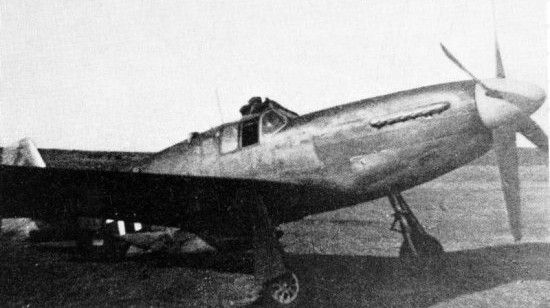 |
| T9+CK, a P-51B which was restored to flying status by the Germans and evaluated at Rechlin. |
The introduction of the Merlin-engined P-51 Mustang in Europe in late 1943 and early 1944 clearly turned the tide against the Luftwaffe. The allied strategic bombardment campaign against Germany had been effectively countered by the Luftwaffe's Jagdruppen, and bomber units suffered heavy losses during daylight raids - sometimes up to 40%. This was largely due to the fact that the bombers could only be escorted up to Belgium and the Netherlands. Short-ranged Spitfires and Thunderbolts had to return to their bases after reaching this area, leaving the bomber formations unescorted until they once again returned within fighter coverage on their way home. The Luftwaffe's top command was quick to realize this weakness and use it to its advantage : as soon as the fighter escorts got low on fuel and turned back to base, swarms of German interceptors were directed against the bombers, which proved incapable of effectively defending themselves.
The Mustang changed the aspect of the air war. Because it was able to escort the 'Big Friends" on their 1100-mile trip to the target and back, German fighter forces started suffering greater losses. In addition to its long range, the P-51 was an able dogfighter, capable of dealing with Germany's Fw 190 and Me 109 fighters, and totally outclassing older designs such as the Me 110 which had until then been used successfully against the sluggish and unmaneuverable bombers. Such was the Mustang's potential that on January 11, 1944, Major James Howard single-handedly attacked a group of Me 110 and shot down 5 of them. It was clear to all that the new aircraft, by supporting the bomber offensive, would eventually lead to the Luftwaffe's defeat. Walter Wolfrum, a Luftwaffe ace with 137 victories, remembered of his encounters with American fighters that "the P-47 wasn't so bad because we could out turn and outclimb it, initially. [...] The P-51 was something else. It could do everything we could do and do it much better. First off, it was hard to recognize. Unless you saw it from the side, it looked like a Me 109. This caused us trouble from the outset. We would see them, think they were ours and then the damned things would shoot us full of holes. We didn't like them at all! " .
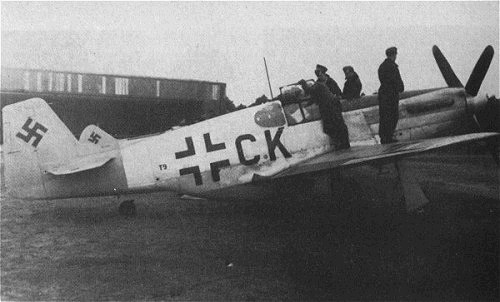 |
| T9+CK in front of a German hangar. |
For the Luftwaffe, devising new tactics against the bombers - i.e. around the escorts - became a top priority. Aircraft wrecks were investigated and salvageable parts were recuperated. In the same fashion fuel, lubricants and ammunition were recuperated for study and a possible future use. The most famous user of captured aircraft was KG-200, whose special missions have remained clouded in mystery. However, it was not the infamous KG-200 but another, smaller, unit that was to make the most out of the captured aircraft. In 1943, Hauptmann 'Ted' Rosarius was tasked with forming a Versuchsstaffel of captured enemy aircraft that would serve to familiarise pilots of the Reichsverteidigung (German air defence) with the strengths and weaknesses of Allied fighter aircraft. This unit, the 2nd Staffel of the Versuchtverband Oberkommando der Luftwaffe (Trials and Research Unit of the Luftwaffe High command) received all of the captured aircraft. Once those had been thoroughly flown and tested, they were flown to different frontline units. This unusual formation became known as the Wanderzirkus Rosarius (Rosarius' travelling circus).
Thanks to Rosarius' Circus, German pilots gained better knowledge of the equipment pitted against them. The aircraft tested by the Circus included P-38 Lightnings, at least three P-47 Thunderbolts, Spitfires, Mosquitoes and a Typhoon. Interestingly, at least one of the Spitfires was incomplete and had been refitted with the nose and engine of a Bf 109, making it a most curious hybrid. A B-17 was also used on such tours to show the Luftwaffe's pilots what the aircraft's strength were, and, more to the point, what its weaknesses were. By studying what the defensive guns' firing arcs were, where the armour and fuel tanks were located, german pilots gained invaluable knowledge.
All of these captured aircraft had their original nationality markings removed and replaced with German Balkenkreuz crosses. In most cases, the original paint scheme was retained, although the underside and tail section were painted in bright RLM 04 yellow, lest some overzealous anti-aircraft gun battery crew fire at the aircraft the Luftwaffe had spent months acquiring and restoring. The unit's code was T9.
Captured Mustangs
Sources concerning the exact identity and number of Mustangs that flew in the Rosarius Circus are rare and usually lack precision and/or reliability. It would appear at least two P-51B/C and up to four P-51D were operated by the Circus.
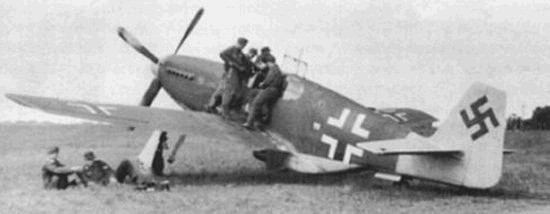 |
| The presence of a Mustang bearing German crosses and swastikas seems to intrigue some of the men on this photograph, while the rest have decided American wings were just as good as German ones when used as sunshades. |
One of the first attested Mustang in German hands was "T9+CK" in early 1944. Its origins remain unclear : did the aircraft land with little or no damage in occpied territory or was it built from different wreckages? It kept the usual US Olive Drab camouflage pattern, apart from the underside and tail section which were painted yellow, and the new nationality marks. Soon, the American fighters stopped being camouflaged : the USAAC was seeking to destroy the Luftwaffe the air and saw no interest in camouflaging their aircraft. In addition to making the aircraft more visible, the absence of paint also slightly reduced the weight and accordingly improved performance. Thus "T9+CK" was rid of its Olive Drab paint, to match the new Mustangs' performance as faithfully as possible. This aircraft was tested at Rechlin and later operated out of Hanover-Wunstorf in the summer of 1944.
Another P-51B, "T9+HK", was also used according to photographic evidence. The prop spinner was painted yellow and a red band went around the front of the nose. The anti-glare pane in front of the cockpit was the standard Olive Drab. As usual, the underside and tail section were also painted yellow. This aircraft was presumably also tested at Rechlin before joining the travelling circus. It was notably used by Hungarian fighter pilots at Neuruppin airfield to learn how to use their Fw-190s to the best advantage against P-51s.
Among the P-51D used by 2.VVB OKL was a model captured by the Germans on D-Day, when it was forced to land in the Cambrai region, in Northern France. This Mustang was also painted in the traditional Olive Drab and Yellow underside fashion as earlier models. It was recaptured by american troops in May 1945. Probably some additional D-model Mustangs were captured and used. At least one aircraft was also stripped of any existing paint job and used for testing and demonstration.
The Circus
Urban legends have arisen concerning the use of captured aircraft by the Luftwaffe. KG-200 is said to have used restored bombers to get into american bomber "boxes" undetected and open fire on unsuspecting aircraft. It is also claimed that Mustangs were used to attack "stragglers" - bombers who had dropped out of formation after taking damage. These reports seem untrue : possibly some aircraft were used to parachute spies in England, but this is probably as glamourous as it gets. Although no hard evidence exists for such things, the Luftwaffe nevertheless did use Allied aircraft rather extensively - but for more straightforward and useful purposes.
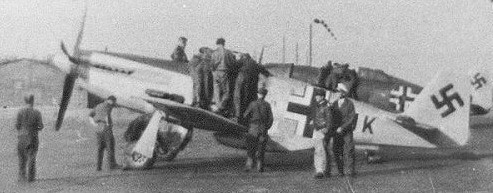 |
| T9+HK, a P-51B being examined by German pilots. A captured P-47 Thunderbolt is also being checked out in the background. |
The increasingly difficult tactical situation the Luftwaffe was experiencing meant that not only testing the Mustang but also using it for demonstration and training was a necessity. In his memoirs, Walther Dahl, a German ace credited with 128 victories, wrote of the ever decreasing number of experienced pilots in the Luftwaffe : "...despite the successes we had enjoyed over the course of our recent sorties, a number of gaps had started to appear in our ranks. Seasoned Staffelkapitäne, experienced Schwarmführer, Leutnante, Feldwebeln and Unteroffiziere - pilots who were the backbone of our unit - had all been posted missing in action . Men such as Oblt. Hirschfeld of 6./JG 300 who was lost in combat on 28 July 1944 and posthumously awarded the Knight's Cross. There were plenty of new young replacements, all volunteering to fly with the Sturmgruppe but virtually none with any front-line experience. Despite the constraints on time, fuel and aircraft availability, it was down to us to complete the training of these youngsters, to " fly them in " under operational conditions as it were."
The lack of experience of younger pilots could be partly compensated for by the demonstrations of the Rosarius Circus. The unit would fly to a new German airbase regularly and show them how the enemy aircraft performed, and how they could be beaten or countered. The fact that Rosarius' Circus was composed of not only different models, but foreign models - with no spare parts supply to speak of - meant that maintaining the aircraft operational must have been a mechanical and logistical nightmare. However, the unit seemed to maintain a decent readiness record, good enough to allow it to fulfill its mission. While Dahl and JG 300 were based at Wörishofen airfield, they were visited by the Circus : "...one morning enemy fighters such as P-51s, P-47s, Lightnings along with the heavy bomber types, could be seen peacefully arrayed alongside our own machines, when their appearance over the field would normally have provoked anything but a friendly reaction.. ."
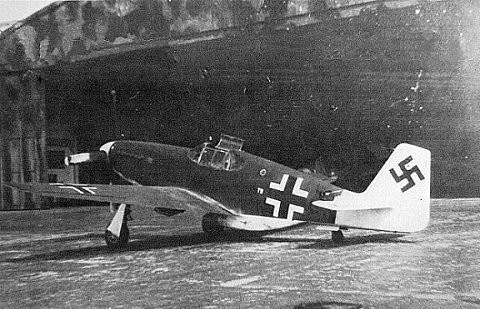 |
| T9+CK parked on a German airbase. The Olive Drab and Yellow paint scheme is evident in this shot. |
Ideally, pilots would have been able to test all of the aircraft flown in by the Circus. However, submitting fragile and rare aircraft to inexperienced pilots could only have brought disaster. In addition, unseasoned pilots would not have been able to judge the aircraft as quickly and efficiently as veteran pilots might. Hence, "only formation leaders (Verbandsführer) were given the possibility of flying these machines in mock combat and thus becoming more closely acquainted with their characteristics, a factor that was not to be under-estimated in air combat with our opponents. Following this session, flight leaders would hold a series of training lectures with their men and were able to pass on recommendations from their own observations and experience at the controls of these aircraft". The value of the experience gained during such sessions should, as Dahl emphasizes, not be overlooked. What nowadays is called "dissymetrical training" is clearly recognized as necessary to efficiently train a pilot. Fighter pilots tend to fly mock aerial combats against their own - men trained in the same fashion and flying the same plane. Such training, while useful, cannot replace actual combat experience. Short of that, "dissymetrical training" is the best thing to do - particularly when the training is made against the same aircraft that will have to be fought in actual combat.
The few pilots who were lucky enough to test-fly the captured Mustangs seemed to appreciate the aircraft. They already knew the Mustang was a very potent adversary to the Luftwaffe's main frontline fighters, the Me 109 and the Fw 190. Walter Wolfrum was among these pilots : "During the war I had the opportunity to fly captured P-47s and P-51s. I didn't like the Thunderbolt. It was too big. The cockpit was immense and unfamiliar. After so may hours in the snug confines of the 109, everything felt out of reach and too far away from the pilot. Although the P-51 was a fine airplane to fly, because of its reactions and capabilities, it too was disconcerting. With all those levers, controls and switches in the cockpit. I'm surprised [their] pilots could find the time to fight. We had nothing like this in the 109. Everything was simple and very close to the pilot. You fitted into the cockpit like a hand in a glove. Our instrumentation was complete, but simple: throttle, mixture control and propeller pitch. How [the] pilots were able to work on all their gadgets and still function amazes me.".
After the test flights, Rosarius' men would participate in the lectures and share advice with the fighting pilots before moving on to another unit and another airfield. This system allowed to compensate partly for the Luftwaffe's growing technical, tactical and "human" inferiority. However, the tide of war had already turned, and there was no fighting against it. Better training, better manufacturing and greater numbers on the Allied's side meant that the Luftwaffe could only fight a desperate war. There was no "secret" to the Mustang, no miraculous engineering feature that German aircraft designers could reverse-engineer and use on their own designs. Out of men and leaders, and later on, out of fuel and ammunition, the Luftwaffe had already lost the air war. When Hermann Goering, commander-in-chief of the Luftwaffe, saw (P-51) fighters escorting bombers over Berlin on March 4 , 1944, he said : "I then realized the war was lost".
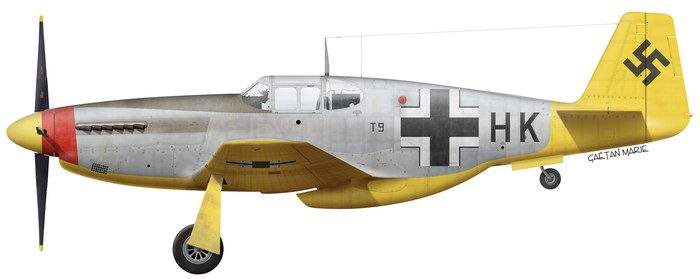 |
| This P-51B-15-NA (s/n 43-24825) nicknamed "Jerry" and assigned to Lt. Thomas E. Fraser of the 4th FG, 334th FS. It was lost in Cambrai, France, on June 6, 1944 and was tested by the Germans at Rechlin, before being transferred to the famous Zirkus Rosarius for training. It was lost on December 10, 1944. Artwork © Gaëtan Marie. |
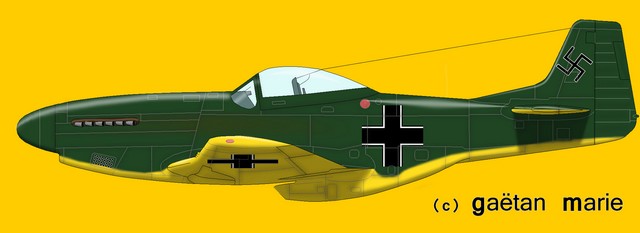 |
| A P-51D from the 2. Staffel of the Versuchsverband der Oberkommando der Luftwaffe. This aircraft was recaptured by American troops in May 1945. At least two P-51D Mustangs had their upper surfaces repainted dark green. The first of these machines was captured near Cambrai on D-Day. Profile by GM for Mustang!. |
Sources:
- D. Breffort & A. Jouineau, P-51 Mustang, de 1940 à 1980, Paris, 2003.
- Extracts from Walther Dahl's memoirs at Kaczmarek
- Extracts from "WWII : Luftwaffe Combat Planes & Aces" quoted on the MustangsMustangs Forum.
- Various personal documents
Further reading:
This article was written by k51d. Version 2.0. Profile by GM for Mustang!. Any addition or correction is welcome.
Advertising |
